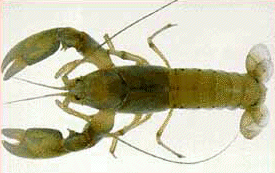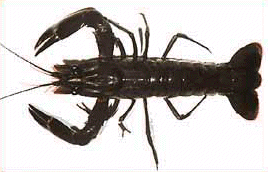Many different creatures and plants use streams. Some live in them all the time, while others only spend a short part of their lives there. Though we don't often see many of them--and some of them are so tiny we often miss them--a collection of living creatures can be easily found in any stream. Ecologists often judge the health of a stream by the numbers of different types of creatures and plants found there; they make collections, then use equations to determine the biological diversity present in the stream. Others use the proportions of certain delicate aquatic invertebrates--those that don't respond well to pollutants--that are present, to calculate an index of stream health.
We know, of course, that stream have fish in them, but it's suprising to see just how many can be found there! In a typical mountain stream, one may find not only trout, but also young salmon, and many species of sculpins. The young salmon are so small they will not take a baited hook, and so we don't see them. Sculpins are fish that are adapted to live tightly against the bottom of the stream, called the substrate. In a Southwest desert stream, one might find masses of tiny minnows and an occasional catfish or bass. There are far too many kinds of fishes in rivers to list here.
Some of the world's largest rivers are home to some large, ancient fishes, including the paddlefish, gar, sturgeon, and the Yangtze River's gladiator fish. Eels and lamprey are found in many rivers. Some African rivers have fish that can communicate with electrical signals. Even a number of shark and ray species live out their whole lives in freshwater, and others who usually live in the sea will sometimes swim up river mouths. Bull sharks are famous for this and can sometimes be found at some distance up the San Juan, Amazon, and Mississippi Rivers. Reptiles found in streams and rivers include turtles, snakes, alligators, and crocodiles. Even iguanas will use streams as escape routes, swimming underwater to get away from predators.
Other small residents of streams that are usually present are frogs, salamanders, and crayfish. Salamanders are very slow-moving amphibians, related to frogs and toads, that are adapted to live in water and often use gills to breathe underwater; most of them, like frogs, live on the damp edges of the stream. Their young, which have gills, live in the river until they emerge, gill-less, for their adult lives.
Crayfish (also known as "crawfish" or "crawdads") are small crustaceans that look much like lobsters. They are decapods (have 10 feet) (Phylum: Arthropoda; Class: Crustacea). Most Americans think of crayfish as living only in the Mississippi River, in Louisiana. However, a wealth of species of crayfish exist all over the world. In fact, there are even blind crayfish--and blind fish and blind salamanders--that live in underground rivers. There are crayfish in Europe, Asia, and Australia; in Southwestern Australia there lives the marron, a kind of giant crayfish that is easily as prized by human diners as is any lobster. The yabbie is a little smaller, more wide-spread, and easy to raise--and that is just what many people do, in their own farm-ponds. The Chinese, the world's oldest and most talented aquaculturists, are raising crayfish for food.
Other forms of life are so tiny that we often miss them--and some can only be found if we look for them. Streams are home to mussels (many of them endangered species), tiny fingernail clams, and snails (Phylum: Mollusca). Many worms are present, including flatworms, annelids, and nematodes. Leeches are very common. Many flies and beetles spend their larval or nymphal stages there (Phylum: Arthropoda; Class: Insecta). Water mites (Phylum: Arthropoda; Class; Arachnida), often called Hydracarina, are so small they can barely be seen by the naked eye.
Finally, there are the organisms that are so tiny that a microscope will be needed to see them, and these may include the ostracods (Phylum: Arthropoda; Class: Crustacea), protozoa, fungi, algae, and bacteria. Many organisms live as parasites, attached to or inside the bodies other animals. These will only be seen if you collect the animals or dissect them.
Bears and wolves fish rivers for salmon, and other mammals that hunt for food in the river include the playful river otter, raccoon, bobcat, cougar, fisher, and mink. Rodents like muskrats and nutria like streams. Beavers are rodents that live in the water, often backing the water up into ponds with their dams, but they get their meals on land. At night, they emerge to eat the tender inner bark of streamside trees. You are most likely to detect the presence of all of these creatures by the presence of a pond. On the banks of a pond or stream you might see their "leftovers"--stumps of trees that have been completely chewed off for use in dams. You might also see the impressions their paws have left in the mud beside the stream.
Dolphins are mammals that we usually associate only with the ocean, but they can be found in rivers, too. A great variety of dolphins may be found all over the world, in rivers like the Amazon R. in Brazil and the Ganges R. in India. A river mammal with a terrible temper and often deadly jaws is the hippopotamus.

 Primary Producers: the Plants
Primary Producers: the Plants Aquatic Invertebrates: Food for Fish
Aquatic Invertebrates: Food for Fish Take a Quick Peek at Some Crayfish
Take a Quick Peek at Some Crayfish The Fishes
The Fishes Trout and Salmon
Trout and Salmon Play a Watershed Game! Be an Explorer or a Detective!
Play a Watershed Game! Be an Explorer or a Detective! 
| Site Search |
Footprints you might find |
||||
| River Otter | Raccoon | Mink | Muskrat | Beaver |
|---|---|---|---|---|
 River otters are rare, due to over-hunting for their rich fur during the European settlement of America. The ones who remain tend to be very shy, and come out mostly at night. Their footprints are all you are likely to see of them. The hindfeet are webbed, and may show this in a good footprint. Another sign that otters are near are thin slides down the river banks where otters have been sliding down for fun. |
 Raccoons don't spend much time in the water, but they spend a lot of time next to it, looking for fish, crayfish, salamanders, and molluscs. Common, sociable, and bold, they are easy to spot! Notice that they walk pigeon-toed. |
 Minks suffered the same over-hunting for their fur that river otters did, and are therefore not easy to find. They may be found in damp climates and quiet bodies of water, such as ponds, marshes, and slow streams. As you can see from its footprints, the mink does not walk, like a raccoon, but bounds, keeping its front and hind feet close to each other. |
 Muskrats are found in much the same kinds of places as minks. They may have burrowed into a streambank for a den, or built a mounded dwelling of marsh plants. The line running between the left and right feet is a depression left by the muskrat's tail. |
 The first sign most people see of beavers is their "logging" work. The shores of the stream may have whole areas where small trees have been gnawed off and dragged away, leaving the stumps. You may be able to see from their footprints that they have a slow, waddling, pigeon-toed walk. |

Orconectes rusticus, rusty crayfish |
Procambarus clarkii, red swamp crayfish |

Cherax albidus, yabbie |

Cherax tenuimanus, marron |
Cherax quadricarinatus, red claw crayfish |